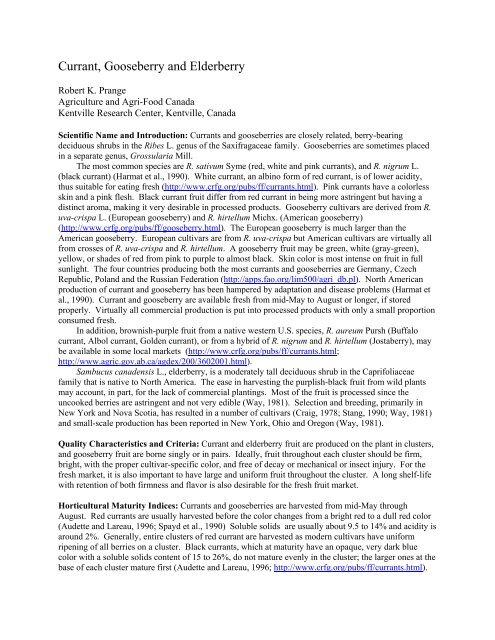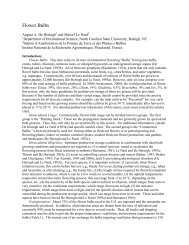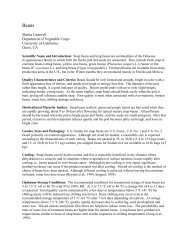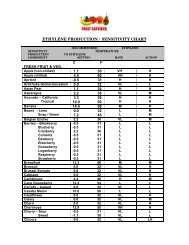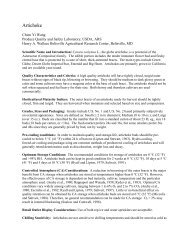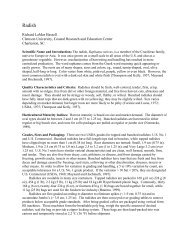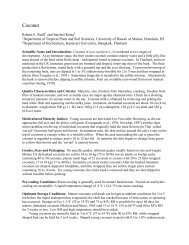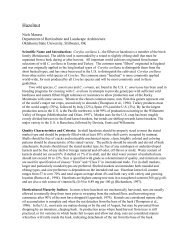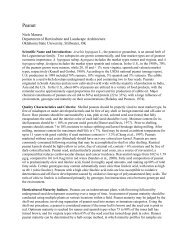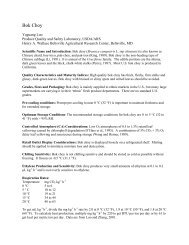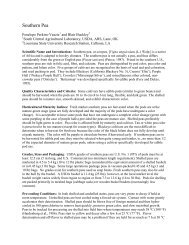Currant, Gooseberry and Elderberry
Currant, Gooseberry and Elderberry
Currant, Gooseberry and Elderberry
You also want an ePaper? Increase the reach of your titles
YUMPU automatically turns print PDFs into web optimized ePapers that Google loves.
<strong>Currant</strong>, <strong>Gooseberry</strong> <strong>and</strong> <strong>Elderberry</strong><br />
Robert K. Prange<br />
Agriculture <strong>and</strong> Agri-Food Canada<br />
Kentville Research Center, Kentville, Canada<br />
Scientific Name <strong>and</strong> Introduction: <strong>Currant</strong>s <strong>and</strong> gooseberries are closely related, berry-bearing<br />
deciduous shrubs in the Ribes L. genus of the Saxifragaceae family. Gooseberries are sometimes placed<br />
in a separate genus, Grossularia Mill.<br />
The most common species are R. sativum Syme (red, white <strong>and</strong> pink currants), <strong>and</strong> R. nigrum L.<br />
(black currant) (Harmat et al., 1990). White currant, an albino form of red currant, is of lower acidity,<br />
thus suitable for eating fresh (http://www.crfg.org/pubs/ff/currants.html). Pink currants have a colorless<br />
skin <strong>and</strong> a pink flesh. Black currant fruit differ from red currant in being more astringent but having a<br />
distinct aroma, making it very desirable in processed products. <strong>Gooseberry</strong> cultivars are derived from R.<br />
uva-crispa L. (European gooseberry) <strong>and</strong> R. hirtellum Michx. (American gooseberry)<br />
(http://www.crfg.org/pubs/ff/gooseberry.html). The European gooseberry is much larger than the<br />
American gooseberry. European cultivars are from R. uva-crispa but American cultivars are virtually all<br />
from crosses of R. uva-crispa <strong>and</strong> R. hirtellum. A gooseberry fruit may be green, white (gray-green),<br />
yellow, or shades of red from pink to purple to almost black. Skin color is most intense on fruit in full<br />
sunlight. The four countries producing both the most currants <strong>and</strong> gooseberries are Germany, Czech<br />
Republic, Pol<strong>and</strong> <strong>and</strong> the Russian Federation (http://apps.fao.org/lim500/agri_db.pl). North American<br />
production of currant <strong>and</strong> gooseberry has been hampered by adaptation <strong>and</strong> disease problems (Harmat et<br />
al., 1990). <strong>Currant</strong> <strong>and</strong> gooseberry are available fresh from mid-May to August or longer, if stored<br />
properly. Virtually all commercial production is put into processed products with only a small proportion<br />
consumed fresh.<br />
In addition, brownish-purple fruit from a native western U.S. species, R. aureum Pursh (Buffalo<br />
currant, Albol currant, Golden currant), or from a hybrid of R. nigrum <strong>and</strong> R. hirtellum (Jostaberry), may<br />
be available in some local markets (http://www.crfg.org/pubs/ff/currants.html;<br />
http://www.agric.gov.ab.ca/agdex/200/3602001.html).<br />
Sambucus canadensis L., elderberry, is a moderately tall deciduous shrub in the Caprifoliaceae<br />
family that is native to North America. The ease in harvesting the purplish-black fruit from wild plants<br />
may account, in part, for the lack of commercial plantings. Most of the fruit is processed since the<br />
uncooked berries are astringent <strong>and</strong> not very edible (Way, 1981). Selection <strong>and</strong> breeding, primarily in<br />
New York <strong>and</strong> Nova Scotia, has resulted in a number of cultivars (Craig, 1978; Stang, 1990; Way, 1981)<br />
<strong>and</strong> small-scale production has been reported in New York, Ohio <strong>and</strong> Oregon (Way, 1981).<br />
Quality Characteristics <strong>and</strong> Criteria: <strong>Currant</strong> <strong>and</strong> elderberry fruit are produced on the plant in clusters,<br />
<strong>and</strong> gooseberry fruit are borne singly or in pairs. Ideally, fruit throughout each cluster should be firm,<br />
bright, with the proper cultivar-specific color, <strong>and</strong> free of decay or mechanical or insect injury. For the<br />
fresh market, it is also important to have large <strong>and</strong> uniform fruit throughout the cluster. A long shelf-life<br />
with retention of both firmness <strong>and</strong> flavor is also desirable for the fresh fruit market.<br />
Horticultural Maturity Indices: <strong>Currant</strong>s <strong>and</strong> gooseberries are harvested from mid-May through<br />
August. Red currants are usually harvested before the color changes from a bright red to a dull red color<br />
(Audette <strong>and</strong> Lareau, 1996; Spayd et al., 1990) Soluble solids are usually about 9.5 to 14% <strong>and</strong> acidity is<br />
around 2%. Generally, entire clusters of red currant are harvested as modern cultivars have uniform<br />
ripening of all berries on a cluster. Black currants, which at maturity have an opaque, very dark blue<br />
color with a soluble solids content of 15 to 26%, do not mature evenly in the cluster; the larger ones at the<br />
base of each cluster mature first (Audette <strong>and</strong> Lareau, 1996; http://www.crfg.org/pubs/ff/currants.html).
The entire cluster can be harvested or only mature berries can be picked over several harvests. At<br />
maturity, gooseberry cultivars may be green, white, yellow or various shades of red (pink to purple to<br />
almost black). Since both immature (green) <strong>and</strong> ripe gooseberries are used, harvest maturity depends<br />
entirely on end use (Ryall <strong>and</strong> Pentzer, 1982). Green gooseberries are very firm <strong>and</strong> tart, whereas some<br />
cultivars, when fully mature <strong>and</strong> soft, are quite sweet. Elderberries are harvested in late August <strong>and</strong><br />
September when the fruit are sufficiently large <strong>and</strong> the fruit has changed to an acceptable purplish-black<br />
color. The fruit do not mature at the same time, so several pickings are necessary over a 1 to 2 week<br />
period (Craig, 1978; Way, 1981). Harvesting occurs in late August <strong>and</strong> September, depending on climate<br />
<strong>and</strong> cultivar. Postharvest decay of currant, gooseberry <strong>and</strong> elderberry can be minimized by avoiding<br />
picking wet or over-ripe fruit.<br />
Grades, Sizes <strong>and</strong> Packaging: There are no U.S. fresh fruit st<strong>and</strong>ards for these fruits. There is a U.S.<br />
grade st<strong>and</strong>ard for processing currants, based on color, attachment of stem <strong>and</strong> freedom from decay or<br />
insect or mechanical damage. Processors, who use most of the commercial production, may have their<br />
own st<strong>and</strong>ards. Since fresh market volumes are not large, container sizes <strong>and</strong> packaging for the fresh<br />
market tend to be those used for similar, but more common, berries, eg., raspberries.<br />
Pre-cooling Conditions: <strong>Currant</strong>, gooseberry <strong>and</strong> elderberry fruit are relatively perishable fruit. Quick<br />
cooling after harvest to recommended storage temperature is desirable, using forced-air cooling with a RH<br />
of 95% (Batzer <strong>and</strong> Helm, 1999; Kasmire <strong>and</strong> Thompson, 1992).<br />
Optimum Storage Conditions: Since currant, gooseberry <strong>and</strong> elderberry are not chilling sensitive (see<br />
below), the recommended storage temperature <strong>and</strong> RH for all three is - 0.5 to 0 °C (31.1 to 32 °F) with<br />
high RH of 95% (Hardenburg et al., 1986; Story <strong>and</strong> Simons, 1989). Batzer <strong>and</strong> Helm (1999)<br />
recommended slightly warmer temperatures of 0 to 1 °C (32 to 34 °C) for red currant <strong>and</strong> gooseberry <strong>and</strong><br />
0 to 2 °C (32 to 36 °F) for black currant, perhaps to avoid accidental freezing. With proper cooling, the<br />
storage duration can be 1.5 , 2.5, <strong>and</strong> 3 weeks for black currant, red currant <strong>and</strong> gooseberry, respectively<br />
(Batzer <strong>and</strong> Helm, 1999).<br />
Controlled Atmosphere (CA) Considerations: As summarized by Batzer <strong>and</strong> Helm (1999) <strong>and</strong><br />
Thompson (1998), research indicates red currant <strong>and</strong> gooseberry respond very well to CA, whereas black<br />
currant benefits only slightly. Storage duration of red currant can be extended to 8 to 14 weeks,<br />
depending on cultivar, using 1 °C (33.8 °F), 18 to 20% CO 2 + 2% O 2 . For gooseberry, storage duration is<br />
extended to 6 to 8 weeks, using 1 °C, 10 to 15% CO 2 + 1.5% O 2 . Increasing the CO 2 up to 20% reduces<br />
incidence of storage rots (Batzer <strong>and</strong> Helm, 1999; Thompson, 1998), <strong>and</strong> lowering the O 2 reduces<br />
respiration rate (Robinson et al., 1975). Compared with red currant <strong>and</strong> gooseberry, black currant does<br />
not respond as well to low O 2 <strong>and</strong> its storage can only be extended to 3 weeks, using 0 to 2 °C (32 to 35.6<br />
°F) <strong>and</strong> 15 to 20% CO 2 .<br />
There is no known information on the effect of CA on elderberry.<br />
Retail Outlet Display Considerations: <strong>Currant</strong>, gooseberry, <strong>and</strong> elderberry should be kept in a<br />
refrigerated display but not sprinkled with water or top-iced.<br />
Chilling Sensitivity: <strong>Currant</strong>, gooseberry <strong>and</strong> elderberry are not chilling sensitive (Kader, 1992).<br />
Ethylene Production <strong>and</strong> Sensitivity: No data available.<br />
Respiration Rates:<br />
Temperature <strong>Gooseberry</strong> Black currant<br />
(mg CO 2 kg -1 h -1 )
0 °C 6 to 8 16<br />
4 to 5 °C 8 to 16 28<br />
10°C 12 to 34 42<br />
15 to 16°C 30 to 74 96<br />
20 to 21°C 46 to 116 142<br />
To get mL kg -1 h -1 , divide the mg kg -1 h -1 rate by 2.0 at 0 °C (32 °F), 1.9 at 10 °C (50 °F), <strong>and</strong> 1.8 at 20 °C<br />
(68 °F). To calculate heat production, multiply mg kg -1 h -1 by 220 to get BTU per ton per day or by 61 to<br />
get kcal per metric ton per day. <strong>Gooseberry</strong> data are from Hardenburg et al., 1986; Robinson et al., 1975;<br />
<strong>and</strong> Smith, 1967. Black currant data are from Robinson et al., 1975.<br />
Physiological Disorders: CO 2 above 20% results in internal breakdown <strong>and</strong> fruit discoloration in some<br />
red currant cultivars after 13 weeks storage (Thompson, 1998). Low O 2 further increases these<br />
symptoms. Smith (1967) showed that green gooseberry fruit held at 0 °C (32 °F) in air were damaged by<br />
CO 2 if it was increased from 8 to 12%. Fruit turned yellow <strong>and</strong> had an abnormal flavor. Increasing the<br />
temperature from 0 to 5 °C (32 to 41 °F) eliminated the disorder.<br />
Postharvest Pathology: The main postharvest disease is Gray mold rot (Botrytis cinerea) which can<br />
appear as small brown spots on currant <strong>and</strong> gooseberry fruit (Dennis, 1983; Harmat et al., 1990; Ryall <strong>and</strong><br />
Pentzer, 1982). These enlarge rapidly at temperatures above 10 °C (50 °F) <strong>and</strong> gradually affect the entire<br />
berry with a soft rot. <strong>Currant</strong> <strong>and</strong> gooseberry fruit can be susceptible to American powdery mildew<br />
(Sphaerotheca mors-uva) (Audette <strong>and</strong> Lareau, 1996; Harmat et al., 1990). Fruit that become<br />
contaminated by soil splash after heavy rain are frequently infected by Mucor piriformis (Dennis, 1983).<br />
Dennis (1983) also reports a fruit disease in gooseberry caused by Alternaria <strong>and</strong> Stemphyllum. The<br />
infection is usually confined to the seeds enclosed in the pericarp. If, however, the fruit is stored for a few<br />
days at ambient temperature prior to consumption or processing, the fungus invades the pericarp tissue.<br />
Several insects can attack the fruit: <strong>Currant</strong> maggot or fruit fly (Epochra canadensis) (North America);<br />
<strong>Gooseberry</strong> fruitworm (Zophodia convolutella) (North America) <strong>and</strong> <strong>Currant</strong> moth (Incurvaria capitella)<br />
(Europe) (Harmat et al., 1990). In addition, slugs <strong>and</strong> snails (Helix aspersa <strong>and</strong> Cepaea spp.) will attack<br />
fruit (North America <strong>and</strong> Europe) (Harmat et al., 1990). Diseases <strong>and</strong> insects are not generally serious on<br />
elderberries (Way, 1981), perhaps due to the absence of extensive plantings. An unidentified mildew can<br />
be a problem on ripe fruit, especially if the weather is cool during ripening <strong>and</strong> there is poor air<br />
circulation around the plants (Way, 1981).<br />
Bird feeding on ripe currant, gooseberry <strong>and</strong> elderberry fruit can be a serious pest problem (Harmat<br />
et al., 1990; Stang, 1990; Way, 1981). In addition to prompt harvesting of ripe fruit, various bird repellent<br />
measures may have to be considered.<br />
Quarantine Issues: None<br />
Suitability as Fresh-cut Product: No current potential<br />
Special Considerations: Ribes species are hosts for the White pine blister rust, which causes few<br />
problems for currants or gooseberries but is dangerous to 5-needle pine species. Thus, commercial<br />
production of Ribes species, especially black currant, may be banned in some U.S. municipalities<br />
(http://www.crfg.org/pubs/ff/currants.html).<br />
References:<br />
Audette, M. <strong>and</strong> M.J. Lareau. 1996. <strong>Currant</strong>s <strong>and</strong> gooseberries culture guide. Conseils des productions<br />
végétales du Québec Inc., Québec City, Canada.<br />
Batzer, U. <strong>and</strong> H.-U. Helm. 1999. Lagerung von Beerenobst (Storage of small fruits). Erwerbsobstbau
41:51-55.<br />
Craig, D.L. 1978. <strong>Elderberry</strong> culture in eastern Canada. Agric. Canada Pub. 1280, Ottawa, Canada.<br />
Dennis, C. 1983. Soft fruits. In: C. Dennis (ed) Postharvest pathology of fruits <strong>and</strong> vegetables. Acad.<br />
Press, pp. 23-42.<br />
Hardenburg, R.E., A.E. Watada <strong>and</strong> C.Y Wang. 1986. The commercial storage of fruits, vegetables, <strong>and</strong><br />
florist <strong>and</strong> nursery stocks. USDA Agric. H<strong>and</strong>book No. 66 (revised).<br />
Harmat, L., A Porpaczy, D.G. Himelrick <strong>and</strong> G.J. Galleta. 1990. <strong>Currant</strong> <strong>and</strong> gooseberry management. In:<br />
G.J. Galleta et al. (eds) Small fruit crop management. Prentice Hall, NJ, pp. 245-272.<br />
Kader, A.A. 1992. Postharvest biology <strong>and</strong> technology: An overview. In: A.A. Kader (ed) Postharvest<br />
Technology of Horticultural Crops. Univ. Calif. Div. Agric. Natural Res. Pub. No. 3311, pp. 15-20.<br />
Kasmire, R.F., <strong>and</strong> J.F. Thompson. 1992. Selecting a cooling method. In: A.A. Kader (ed) Postharvest<br />
Technology of Horticultural Crops. Univ. Calif. Div. Agric. Natural Res. Pub. 3311, pp. 63-68.<br />
Robinson, J.E., K.M. Browne <strong>and</strong> W.G. Burton. 1975. Storage characteristics of some vegetables <strong>and</strong> soft<br />
fruits. Ann. Appl. Biol. 81:339-408.<br />
Ryall, A.L., <strong>and</strong> W.T. Pentzer. 1982. H<strong>and</strong>ling, transportation <strong>and</strong> storage of fruits <strong>and</strong> vegetables. Vol. 2.<br />
Fruits <strong>and</strong> tree nuts, 2 nd edition, AVI, Westport CT.<br />
Spayd, S.E., J.R. Morris, W.E. Ballinger <strong>and</strong> D.G. Himelrick. 1990. Maturity st<strong>and</strong>ards, harvesting,<br />
postharvest h<strong>and</strong>ling, <strong>and</strong> storage. In: G.J. Galleta et al. (eds) Small Fruit Crop Management.<br />
Prentice Hall, NJ, pp. 504-531.<br />
Smith, W.H. 1967. The storage of gooseberries. Agr. Res. Council (U.K.) Ditton <strong>and</strong> Covent Garden<br />
Labs. Ann. Rpt. 1965-66, p. 13-14.<br />
Stang, E.J. 1990. <strong>Elderberry</strong>, highbush cranberry, <strong>and</strong> juneberry management. In: G.J. Galleta et al. (eds)<br />
Small fruit crop management. Prentice Hall, NJ, pp. 363-382.<br />
Story, A. <strong>and</strong> D.H. Simons. 1989. H<strong>and</strong>ling <strong>and</strong> storage practices for fresh fruit <strong>and</strong> vegetables.<br />
Australian United Fresh Fruit <strong>and</strong> Vegetable Assoc. Ltd., Victoria, Australia.<br />
Thompson, A.K. 1998. Controlled atmosphere storage of fruits <strong>and</strong> vegetables. CAB Intl., Wallingford,<br />
UK.<br />
Way, R.D. 1981. <strong>Elderberry</strong> culture in New York State. NY State Agric. Exp. Sta., Geneva NY, Food<br />
Life Sci. Bull. No. 91.


